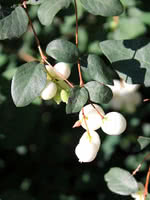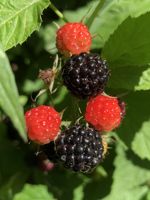Mon-Fri 9am - 5pm Mountain time
Western Snowberry vs Black Raspberry
Symphoricarpos occidentalis
Rubus occidentalis
NOT AVAILABLE THIS SEASON - MIGHT RETURN
Like the Common Snowberry, the Western Snowberry is a small shrub with pink flowers useful for feeding livestock and preventing erosion. Unlike the common species, however, the Western Snowberry is much more suited to wet conditions, capable of persevering through poor soil drainage and occasional flooding.
After the Snowberry's flowers have bloomed, it produces berries which often last on the plant through winter. These berries are toxic to humans, but livestock and local wildlife love them! Those hoping to attract wildlife to their property can plant Snowberry and expect to see animals foraging on it much later in the year than other plants.
The Black Raspberry is a multi-stemmed shrub that produces edible red berries that deepen to black as they mature. The berries are flavorful and are great for fresh eating and preserves. Black Raspberry shrubs bloom in late spring with white, rose-like flowers and attract many pollinators such as bees and butterflies.
Black Raspberries are floricanes primarily fruiting on second year canes. Each spring cut back all two-year old canes, leaving only the last year’s growth.
Western Snowberry Quick Facts
Black Raspberry Quick Facts
Toxicity: berries are toxic to humans

